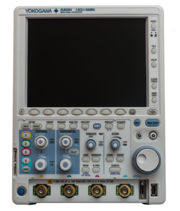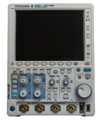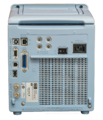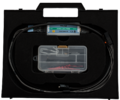Difference between revisions of "Yokogawa DLM2000 series"
Jump to navigation
Jump to search
(Initial version of the page) |
m (Add GPIB) |
||
| (6 intermediate revisions by 3 users not shown) | |||
| Line 1: | Line 1: | ||
{{Infobox oscilloscope | {{Infobox oscilloscope | ||
| image = | | image = [[File:Yokogawa_DLM2000_front.png|180px]] | ||
| name = Yokogawa DLM2000 | | name = Yokogawa DLM2000 series | ||
| status = | | status = supported | ||
| source_code_dir = yokogawa-dlm | | source_code_dir = yokogawa-dlm | ||
| channels = 2 or 4 | | channels = 2 or 4 | ||
| Line 15: | Line 15: | ||
}} | }} | ||
The [http://tmi.yokogawa.com/us/products/oscilloscopes/digital-and-mixed-signal-oscilloscopes/dlm2000-mso-series/ Yokogawa DLM2000 | The [http://tmi.yokogawa.com/us/products/oscilloscopes/digital-and-mixed-signal-oscilloscopes/dlm2000-mso-series/ Yokogawa DLM2000 series] are 2- or 4-channel oscilloscopes with an analog bandwidth of 200-500MHz and 2.5GS/s sampling rate. See [[Yokogawa DLM2000 series/Info]] for more details (such as '''lsusb -v''' output) about the device. | ||
Due to Yokogawa's focus on the controls industry, their oscilloscopes offer extensive analysis and reporting features. | Due to Yokogawa's focus on the controls industry, their oscilloscopes offer extensive analysis and reporting features. | ||
| Line 21: | Line 21: | ||
== Devices == | == Devices == | ||
{| class=" | {| border="0" style="font-size: smaller;" class="alternategrey sigroktable sortable" | ||
!Model || Bandwidth || | !Model || Bandwidth || Channels | ||
|- | |- | ||
|| DLM2022 || 200MHz || 2 | || DLM2022 || 200MHz || 2 | ||
| Line 37: | Line 37: | ||
|} | |} | ||
== | == Photos == | ||
<gallery> | |||
File:Yokogawa_DLM2000_front.png|<small>Device, front</small> | |||
File:Yokogawa_DLM2000_back.png|<small>Device, back</small> | |||
File:Yokogawa_PBL250.png|<small>PBL250 logic probe</small> | |||
</gallery> | |||
== | == Protocol == | ||
The device uses [[GPIB]], [[USBTMC]] or LXI via its ethernet port for communication with a host PC. The protocol is based on SCPI commands. | |||
== Resources == | == Resources == | ||
| Line 55: | Line 59: | ||
[[Category:Oscilloscope]] | [[Category:Oscilloscope]] | ||
[[Category:Mixed-signal oscilloscope]] | [[Category:Mixed-signal oscilloscope]] | ||
[[Category:Supported]] | |||
Latest revision as of 20:25, 1 September 2014
 | |
| Status | supported |
|---|---|
| Source code | yokogawa-dlm |
| Channels | 2 or 4 |
| Samplerate | 2.5GSa/s (2chs interleaved), 1.25GSa/s |
| Analog bandwidth | 200-500MHz (depending on model) |
| Vertical resolution | 8bits |
| Input impedance | 1MΩ‖20pF 150V RMS CAT I or 50Ω 5V RMS |
| Memory | 6.25 to 250Mpts (model/mode-dependent) |
| Display | 8.4" 1024x768 |
| Connectivity | USB host/device, Ethernet (optional), Trigger in/out, GO/NOGO, VGA out |
| Website | yokogawa.com |
The Yokogawa DLM2000 series are 2- or 4-channel oscilloscopes with an analog bandwidth of 200-500MHz and 2.5GS/s sampling rate. See Yokogawa DLM2000 series/Info for more details (such as lsusb -v output) about the device.
Due to Yokogawa's focus on the controls industry, their oscilloscopes offer extensive analysis and reporting features.
Devices
| Model | Bandwidth | Channels |
|---|---|---|
| DLM2022 | 200MHz | 2 |
| DLM2032 | 350MHz | 2 |
| DLM2052 | 500MHz | 2 |
| DLM2024 | 200MHz | 4 analog / 3 analog+8 digital |
| DLM2034 | 350MHz | 4 analog / 3 analog+8 digital |
| DLM2054 | 500MHz | 4 analog / 3 analog+8 digital |
Photos
Protocol
The device uses GPIB, USBTMC or LXI via its ethernet port for communication with a host PC. The protocol is based on SCPI commands.


